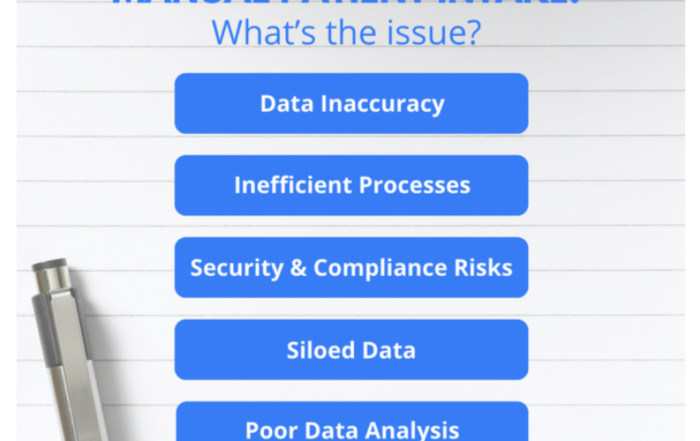Is a Better Patient Experience a New Healthcare Trend for 2020? How is healthcare technology improving the patient experience or more simply, making your visit to the doctor’s office more efficient and enjoyable?
Choosing between the doctors’ office, the emergency room, and your local urgent care center is never easy. Still, new technologies are helping patients streamline health emergencies and general healthcare at any stage of the patient journey. By streamlining internal operations and new and evolving technologies designed with the consumer in mind, it’s becoming more accessible than ever to deliver the best care to patients across the country. Patients are the new customer and want, as well as demand, better patient experience with their healthcare.
Recent reports estimate that the healthcare IT market will be worth over $390 billion by 2024 alone. Whether you’re a curious patient or a doctor trying to stay on top of the current trends, here’s everything you should know about healthcare innovation trends for 2020.

3D Printing
Not surprisingly, 3D printing has been all the rage across technology platforms. From art to IT to the doctor’s office, this innovative printing tool has enabled countless people to experiment with time-old traditions and improve operations. No other market has benefited from 3D technology as much as the healthcare industry.
3D printing has been a leading force in the healthcare industry, thanks to its variety of applications. 3D-printed hearts have helped medical students get a better grasp of human anatomy, while prosthetics makers have revolutionized custom-fitted options for amputated limbs.
Some medical experts have even experimented with 3D printing living cells to reconstruct damaged tissues. This can help repair damaged tissues or experiment with new treatment options. Even the FDA has gotten on-board with some of these organic printing applications. In 2020, there’s no telling where 3D Printing will take us.
Virtual Reality
The benefits of virtual reality (VR) and augmented reality platforms go beyond playing video games in your living room. In the medical industry, VR and AR have become one of the best ways to treat phobias, anxiety, and fear.
Known as exposure therapy, VR has become a zero-risk practice in helping people overcome their greatest fears. By gradually exposing the individual to fear in a safe place, people have been able to tackle their fear of heights, beat concerns over flying, and get used to walking around dogs.
But virtual reality isn’t confined to the patient. These VR options have also helped medical students simulate surgeries and other essential (and expensive) training. While we don’t expect virtual operations to replace real-life experiences, this is a great introductory process to get a new student acquainted with the practice and sharpen their skills over time. It’s no wonder that Forbes thinks that virtual reality will be worth over $5 billion by 2025.

5G Data Speeds
Few industries rely on instantaneous communication more than the healthcare industry. When lives are on the line, your doctors, surgeons, and nurses need every tool in the shed to deliver the best care. That’s why one of the most important innovations in healthcare next year will be 5G integration.
5G data offers the best in bandwidth that we’ve seen to date. Since countless medical professionals rely on lightning-quick speeds to update patient records, download important files, and communicate in real-time, we can expect hospitals to be early adopters of 5G technology.
According to Modern Healthcare, using 5G speeds enables the user to download a file up to 100 times faster than they can today. As more healthcare providers also rely on the cloud to streamline communication with patients, this speed becomes more necessary than ever.
While 5G isn’t readily available to everyone in the U.S. just yet, we can expect more and more hospitals to adopt and integrate this technology in 2020.
Deep Learning
It’s no secret that pharmaceutical companies and researchers are working hard to discover and develop new drug treatment options for a range of diseases. However, the advent of “deep learning” could streamline this process.
First noted for its efficiency in 2019, deep learning technology is a type of machine learning, akin to artificial intelligence. It rests on the idea that medical systems will be able to communicate and learn much in the way that neurons communicate and become more efficient in the brain. According to McKinsey, machine learning in the medical field has the potential to generate more than $100 billion annually.
Now that many health and medical professionals are uploading their data across the web, deep learning is finding ways to synchronize this information, resulting in new correlations, theories, and insights. With the continued use of machine learning, many health professionals believe that this can help prevent illness in some individuals and lead to new treatments in others.

Personalized treatments
Just like a pair of well-fitted pants, there’s rarely a one-size-fits-all treatment in healthcare. Personalization in the healthcare industry has become more necessary than ever, and many facilities plan to incorporate customization in 2020.
For some medical practices, streamlining value-based healthcare is at the top of their list. By paying physicians for different qualities of healthcare, people are better able to manage their finances and optimize their care. Breaking away from the traditional form of paying by the hour can seem overwhelming to some. Still, blockchain systems and artificial intelligence have made value-based healthcare more realistic than ever before.
Others are looking into more treatment options depending on the needs of the individual, especially when it comes to chronic illnesses and risk factors based on medical history, genetics, and environmental factors, including their career. When so many people look at the medical industry as a cold, unwelcoming field, these kinds of adjustments are becoming increasingly necessary to earn — and maintain — patient trust. While this kind of care has always been a goal of medical providers, the lack of time and technology to achieve these aspects of patient care has been out of reach. Thanks to the advent of telemedicine, patient portals, and artificial intelligence, however, these streamlined modes of communication have opened more doors than we ever thought possible.
These are just some of the technological innovations you will see streamlining healthcare and improving your visit to the doctor’s office. In 2020. As we keep testing the limits of innovation, who knows what will transform healthcare next.











